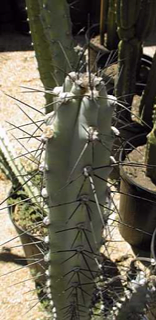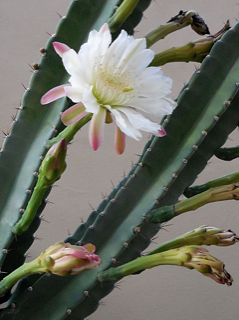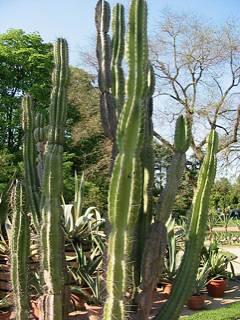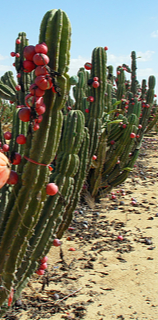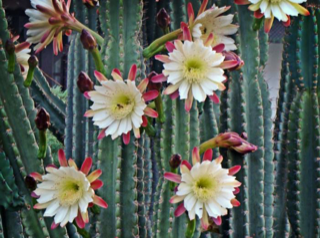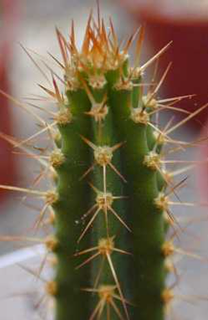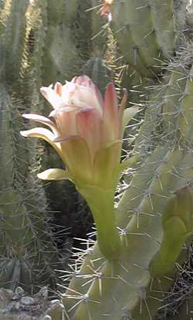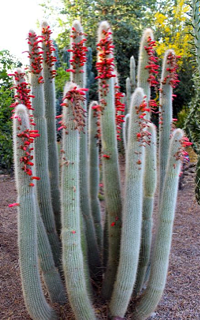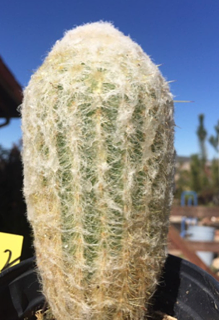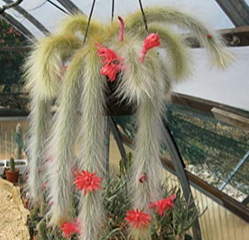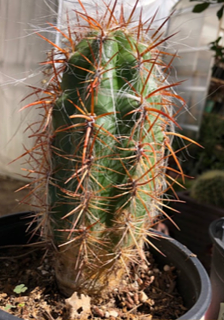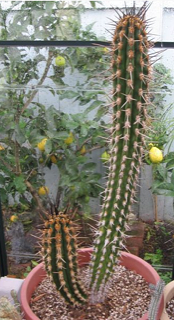Submitted by: Jim Tanner
Columnar cacti are not a closely related set of genera, but a lumping together of all the cacti that are much longer than they are around. Columnar cacti vary in size from a few inches, as in the aptly named, Pygmaeocereus to the giants like Pachycereus and Carnegiea (Saguaro). Most are robust growers, given adequate water, fertilizer, root room and support. They expect more nitrogen in their soil (or plant food) and more water than most globular cacti. They do well in normal cactus soil, as long as they get additional fertilization.
Propagation is generally by cuttings or seed. Cuttings need to be dried well before planting. A few weeks is the minimum for some of the larger columnar species. They do best if dried in an upright position. If placed on their sides the cut end rots easier. Seed of columnar cacti are readily available, and are particularly enjoyable to grow. While all of the globular cacti are the size of a pea, many of the columnar cacti are filling the pot, and an inch or more high. If grown from seed, many will not tolerate crowding for long, and demand their own pot. This is particularly true of Oreocereus, which will quickly stop growing if there is more than one plant per pot.
The plants take many years to reach flowering size, and are only really happy in the ground, and get too big for pots in any case. Some genera are very popular.
Popular South American columnar cactus
Cereus is a genus of cacti including around 33 species of large columnar cacti from South America. Cereus peruvianus, found in many Southern California gardens, has been cultivated for over 400 years, and is not know in the wild!
The flowers do not have areoles or spines, but they have a few scales. They are generally large, white, either funnel or trumpet-shaped. They are followed by a yellow or red fruit, generally edible containing black seeds.
Cleistocactus is one of the most beautiful genera of the columnar cacti. These slender plants branch from the base, and have dense spination. They are easy to grow, and quickly set flowers that are usually long red tubes sticking out through the spines. Some of the best are C. smaragdiflorus, with red flowers, a yellow band near the tip, and a bright green tip. C. strausii is a fuzzy white marvel, and often seen at sale tables at shows.
Espostoa come from Ecuador and Peru. Most of these are covered with a dense white wool that entirely hides the plant body.
Haageocereus come from Peru and Chile. They stay short (for a ceroid), rarely exceeding 3 or four feet, and have dense spines, and showy red flowers.
Micranthocereus is a small genus of Brazilian cacti. All of the species branch from the base, and make densely spined clusters. They stay small, and are happy as pot plants. Quite a few of these have been in the shows in the past few years.
Oreocereus are beautiful hairy plants, with wicked spines hidden in the hairs. Some branch from the base. They prefer outdoor air to a greenhouse, and need frequent turning to keep symmetrical growth.
Pilosocereus is a largely Brazilian genera, almost all of which are worth growing. It has a wide distribution, stretching into central Mexico. Many of the species are a glaucous blue with bright yellow spines and hairy areoles. Pilosocereus magnificus is one of these, with 4 to 12 deep ribs. The outer edges are covered with short yellow spines. Pilosocereus aureispinus has very 18 to 20 shallow ribs, and distinct areoles, that make dense yellow spirals around the plant on a dark green background.
Tom Glavich
LATIN LOOKUP – Loquerisne Latine (Do you speak Latin)?
The meanings of latin plant names on this page – from http://davesgarden.com/guides/botanary/
- atacamensis [a-tah-kah-MEN-sis]
Of or from the Atacama desert in Northern Chile. - celsianus [sels-ee-AY-nus]
Named for Jacques Martin Cels, 18th century French writer, breeder, and plantsman. - Cereus [KER-ee-us, SER-ee-us]
A wax candle, torch. - Cleistocactus [Kly-stoh-KAK-tus]
From the Greek kleistos (closed) and cactus, referring to the closed perianth. - colademononis [koh-luh-dee-mon-OH-nis]
From the Spanish vernacular name Cola de Mono (meaning monkey’s tail). - Echinopsis [ek-in-OP-sis]
From the Greek echinos (sea urchin or hedgehog) and opsis (like), referring to the plant’s resemblance to sea urchins. - Espostoa [es-POS-toh-uh]
Named for Nicolas E. Esposto, a botanist from Lima (Peru). - hildmannianus [hild-man-ee-AH-nus]
For Heinrich Hildmann, 19th century German cactus enthusiast, horticulturist and nursery owner near Berlin. - horridispinum [hor-rid-ih-SPIN-um, hor-rid-ih-SPY-num]
Prickly or bristly spines. - lanata [la-NA-tuh]
Woolly. - Oreocereus [or-ee-oh-KER-ee-us, or-ee-oh-SER-ee-us]
From the Greek oreo (mountain) and cereus (candle). - repandus [REP-an-dus]
Has wavy edges, wavy leaf margins. - spegazzinii [speg-uh-ZIN-ee-eye]
Named for 20th century Italian-born Argentinian botanist Carlo Luigi Spegazzini. - validus [val-EE-dus, VAL-ih-dus]
Well-developed. - weberbaueri [web-er-BAUER-eye]
Named for August Weberbauer, 20th century German botanist who studied cactus from the Peruvian Andes. - Weberbauerocereus [web-er-bawer-oh-SER-ee-us]
Named for August Weberbauer, 20th century German botanist who studied cactus from the Peruvian Andes.
